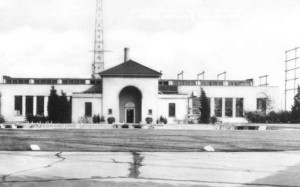A Summer Job in the Days of Telegraph
 When I was fifteen or sixteen I got a summer job with RCA as a messenger boy delivering and picking up RCA Radiograms in the Wall Street area of lower Manhattan. The RCA Central Office for New York City was at 66 Broad Street, in the same area as the Cunard White Star line office and all the other shipping lines offices.
When I was fifteen or sixteen I got a summer job with RCA as a messenger boy delivering and picking up RCA Radiograms in the Wall Street area of lower Manhattan. The RCA Central Office for New York City was at 66 Broad Street, in the same area as the Cunard White Star line office and all the other shipping lines offices.
Across the street was the Western Union office. And a block north was the financial district of Wall Street. The RCA building had a small room open to the street in which I waited to be called. Then there was a large window that separated the street side from the inside of 66 Broad St.
Behind that window, taking telephone messages, was the most beautiful of all God’s creations. She smiled at me whenever I arrived and pushed messages to me or grasped messages I had picked up. Each time I just about died at her recognition of my mere existence. I never spoke to her. I never learned her name. I never forgot her.
As I recall, there were two floors dedicated to outgoing messages and incoming messages respectively at 66 Broad St. Outgoing messages all went to the RCA transmitting site at Rocky Point Long Island. Incoming messages were received at Riverhead Long Island, about 30 miles away, and forwarded to the receiving operators at 66 Broad St. There they were typed onto RCA message forms for delivery to the recipients.
Now let me give you a little more detail on how “the legbone connects to the headbone”. Say I pick up a message from a shipping line in New York to a docking agent in Buenos Aires, Argentina. Well, there is no radio propagation between New York and Argentina for almost the entire day. Maybe around 7:00 pm the band might open for an hour or less. So, all day long the operator designated to prepare outgoing messages for Argentina types up those messages using a Wheatstone punch which puts holes in a paper tape for each letter.
This Wheatstone tape is slowly accumulated into a big roll as messages come in for transmission to Argentina. At the same time, the operator is in communications with the Rocky Point transmitter site and the Riverhead receiver site using a hand-keyed telegraph line and American Morse code (not International Morse).
When Riverhead begins to receive the Argentine signal, the Transmit operator in New York puts on a tape sending the single line “The quick brown fox jumps over the lazy dog’s back 123456789 RCA Sending” over and over again until Argentina is copying it perfectly. That information is transmitted back up to New York and soon all are in agreement that there is a solid circuit between New York and Argentina. Then, the operator replaces the “fox” tape with the huge reel of messages for that day and away they go — at 400 to 750 characters per minute.
At the same time, the messages from Buenos Aires are coming in to the receivers at Riverhead N. Y. and being sent to the Argentine Receiving position at 66 Broad St. where they are printed, in International Morse, as a wiggly, blue line on a paper tape. The tape is wound up on a motor driven reel. The NY – BA circuit may be open for only an hour or so and reel after reel of tape is blue lined in Morse Code and stacked. When the last message has been sent, and any messages repeated because of signal fades, then the operators re-mount the tape reels and begin to type out the next day’s radiograms.
An operator takes a reel of tape and an empty reel and rewinds it so that the Morse Code is not reversed. The tape is fitted into a guide across the top of the typewriter. Then, with a foot pedal, he slowly advances the tape and reads the Morse wiggles and types out the Radiogram. I look over his shoulder and find I can read the Morse wriggles perfectly. I pick up a scrap of used tape from the floor and read it as fast as I can pull it through my fingers. This is GREAT! I rush over to the supervisor and wave the tape. “I can read it!” He grins and takes me to a vacant position. “Let’s see what you can do!” I push the foot pedal and read the first line perfectly. Then I realized the problem —–
I can’t type!!!
Did you enjoy this post? Why not leave a comment below and continue the conversation, or subscribe to my feed and get articles like this delivered automatically to your feed reader.



Do you know the years during which the Radiograms specifically illustrated above were sent?